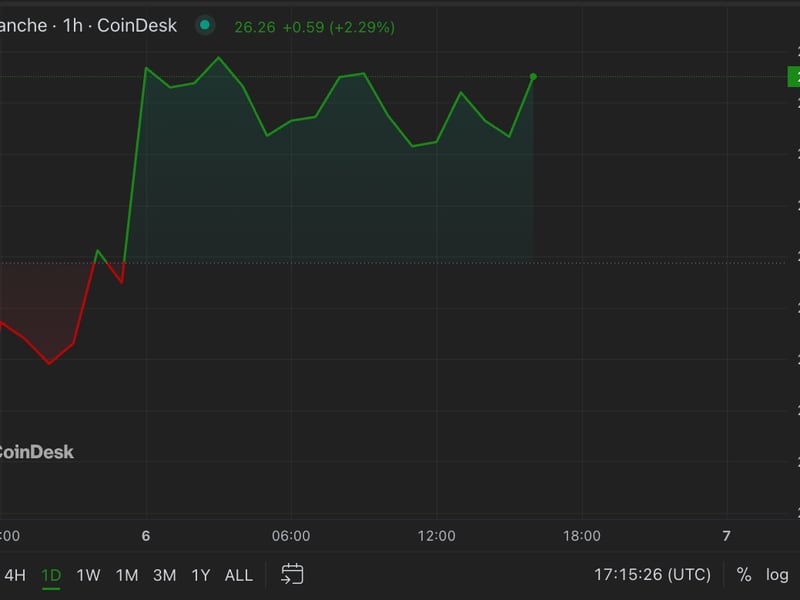First Mover: Bitcoin’s Back in the Black for 2020
Ready to rock? (Credit: Shutterstock/dwphotos)
First Mover: Bitcoin’s Back in the Black for 2020
Bitcoin (BTC) traders are used to the mood swings that come with extreme price volatility. They were elated when prices shot up 30 percent in January, the best start to a year since 2013. They were alarmed and unsettled when the spread of the coronavirus sent prices for the oldest and largest cryptocurrency plunging as low as $3,850 in early March from about $10,200 just a month earlier.
Now, volatility is returning in a positive way, prices are going up and enthusiasm is returning to digital-asset markets. Bitcoin has nearly doubled in price since hitting the March low, and a 7.8 percent rally on Monday brought the cryptocurrency back into the black for 2020. As of early Tuesday, prices were up 4.25 percent on a year-to-date basis.
You’re reading First Mover, CoinDesk’s daily markets newsletter. Assembled by the CoinDesk Markets Team, First Mover starts your day with the most up-to-date sentiment around crypto markets, which of course never close, putting in context every wild swing in bitcoin and more. We follow the money so you don’t have to. You can subscribe here.
Clawing back to that threshold represents a milestone for bitcoin, since the latest coronavirus-triggered sell-off was one of the cryptocurrency’s biggest crises since it was launched in early 2009. Holders are hoping the recent price recovery will attract the notice of mainstream investors, in turn driving more demand for bitcoin. But it also could prove a boon for the marketing efforts of hedge funds and other investment firms that specialize in digital assets, as they seek to woo new institutional clients.

Leaving aside the question of whether bitcoin is a safe-haven asset like gold or Swiss francs, most investors in any asset class would likely be thrilled, given what’s happening right now in the economy, just to get back what they’ve lost since the start of the year. That can’t be said for the Standard & Poor’s 500 Index of large U.S. stocks, which remains down 18 percent in 2020 despite its spectacular rally over the past few weeks.
The positive year-to-date performance just bolsters the pitch for bitcoin in the current environment; many investors in both digital-asset and traditional markets say inflation will likely follow the trillions of dollars of fiscal and monetary stimulus deployed just in the past month by governments and central banks around the world. And bitcoin, sometimes referred to as “digital gold,” is bought by many investors as a new-economy way of hedging against inflation.
Here’s how San Francisco-based Bitwise Asset Management put it in an April update:
“We are in unprecedented times, seeing anomalous and unexpected developments in financial markets, including gold, and witnessing extraordinary fiscal and monetary responses to the coronavirus pandemic. In such an environment, a small allocation to crypto in a diversified portfolio seems increasingly prudent. We are hearing this from clients, and seeing it in our inflows. If considering a small allocation to crypto has been on your to-do list, now may be one of the best possible times to prioritize figuring out your stance.”
And bitcoin’s outperformance is becoming a regular thing. Over 2019, bitcoin surged 94 percent. That was roughly triple the returns the S&P 500 notched during a banner year for the stock index. In hindsight, it may have been the bull market’s final push.
Michael Novogratz, a former Goldman Sachs executive who’s now CEO of the cryptocurrency investment firm Galaxy Digital, told CNBC last week he was fielding calls from investors who have never dipped into the nascent market. According to Novogratz, they all have the same request: “Tell me about this bitcoin.”
Blockforce Capital, a cryptocurrency investment firm in San Diego, said Tuesday in an emailed report its Multi-Strategy Master Fund lost 14 percent in March, while quickly noting (at the top of the document) performance was essentially flat for the year. While the firm said that “cryptocurrencies will remain volatile and widespread institutional adoption will take a very long time,” confidence remains.
“We believe that we can achieve superior risk-adjusted returns that are uncorrelated to the other investments that so many of our clients already own.”
Blockforce Capital
An interesting development over the past week is just how many highly respected old-line Wall Street analysts – even those who don’t follow bitcoin closely – are now predicting a pickup in inflation.
Rich Bernstein, a former Bank of America chief U.S. equity strategist who now runs his own advisory firm, told Barron’s on April 3 he sees stagnation ahead for the economy, if not “stagflation” – where low or flat growth comes at a time of rising consumer prices and high unemployment.
“When you think about the amount of stimulus that is being put in the system worldwide, it seems to me that’s a reasonable proposition that you can have more inflation than people think,” Bernstein said.
And there’s Michael Wilson, a Morgan Stanley equity strategist, who wrote in an April 5 report that “there are literally no governors on the amount of monetary or fiscal stimulus that will be used in this fight.” He continued:
“Not only are we likely to get the largest peacetime fiscal deficit in history, but the stimulus targets the parts of the economy with a higher propensity to spend. Such a dramatic shift in U.S. fiscal and monetary policy relative to other regions should lead to a materially weaker dollar.”
President Donald Trump’s top economic adviser, Larry Kudlow, told CNBC that not only is he in favor of selling government bonds to “raise money for the war effort,” but that “you have fiscal policy working with monetary policy.” The takeaway is, as authorities respond to the pandemic, the U.S. central bank can be called on to provide whatever financing is needed for whatever spending programs the government pursues. Usually, the Federal Reserve acts independently of the government.
With such stark declarations, it’s no wonder crypto traders are banging the drums.
Rich Rosenblum, a former Goldman Sachs managing director who now leads the markets group at the digital-asset trading firm GSR, said in an email bitcoin’s swift sell-off in early March was driven by “non-crypto-dedicated professionals moving risk off the table, starting with liquid assets and regardless of conviction level.”
The group was “largely made up of traditional institutions” that needed to raise cash fast to meet margin calls and quarterly redemptions, he wrote.
In other words, they weren’t even bitcoiners. For those still in the game, or getting in now, the investment case has strengthened.
“The record stimulus being deployed by central banks is a reminder of why bitcoin was created in the fallout of the last global market crisis,” Rosenblum wrote. “People are increasingly skeptical of conventional monetary systems. Bitcoin with its predictable inflationary scheme and 100% uptime offers some certainty in an environment that is otherwise very unpredictable.”
Here’s another approach: Just say bitcoin’s returns are positive for the year and the cryptocurrency is beating the S&P 500 handily for the second straight year. If the inflation narrative doesn’t work, this just might.
– Bradley Keoun, Senior Markets Reporter
Tweet of the day

Bitcoin Watch
BTC: Price: $7,380 (BPI) | 24-Hr High: $7,459 | 24-Hr Low: $7,062

Trend: Bitcoin printed a 3.5-week high of $7,459 early Tuesday, taking the cumulative month-to-date gains to 15 percent. At press time, the cryptocurrency is trading near $7,380, representing a 3 percent year-to-date increase. While bitcoin is again reporting gains for 2020, the S&P 500 index is still down over 17 percent.
The cryptocurrency’s recent rally looks to be confirming that the rapid drop from $8,000 to $4,000 seen on March 12 and 13 was mainly fueled by non-crypto dedicated professionals moving risk off the table amid the coronavirus-led crisis in the financial markets, according to Richard Rosenblum, co-head of trading at GSR.
The long-term case looks bullish, courtesy of the unprecedented monetary and fiscal stimulus launched by central banks and governments across the globe. However, a pullback may be seen in the short run, with signs of buyer fatigue emerging on the technical charts.
To start with, bitcoin’s upward momentum ran out of steam near the descending 50-day average at $7,370 during the Asian trading hours. Further, key indicators on the hourly and 4-hour charts are reporting overbought conditions.
So bitcoin may fall back to the $7,100-$7,000 price range before convincingly rising above the 50-day average hurdle.
– Omkar Godbole
Disclosure Read More
The leader in blockchain news, CoinDesk is a media outlet that strives for the highest journalistic standards and abides by a strict set of editorial policies. CoinDesk is an independent operating subsidiary of Digital Currency Group, which invests in cryptocurrencies and blockchain startups.









